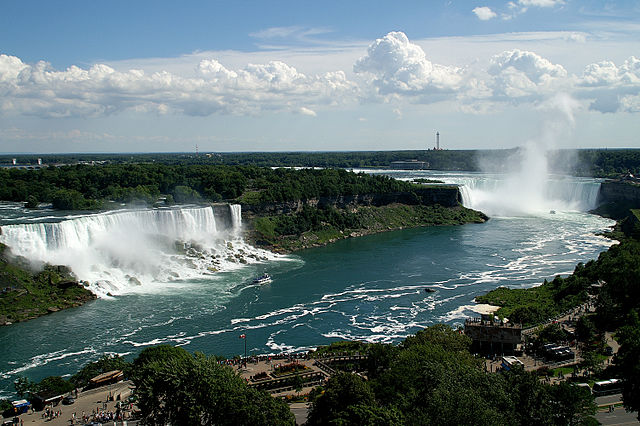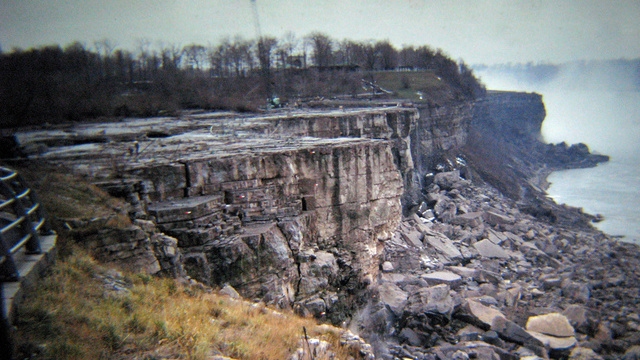
Niagara Falls is a set of three waterfalls on the United States/Canada border. Collectively, they have the highest flow rate of any waterfall in the world, with over 2,400 cubic meters (or about 600,000 gallons) of water going over the edge every second. Horseshoe Falls, pictured right in the above photograph, is the largest of the three, while American Falls and the relatively small Bridal Veils Falls are the ones on the left. (Bridal Falls is the smaller, somewhat isolated waterfall to the right of the larger American Falls.) In the late 1960s, American Falls was exhibiting some rock building at its base, caused by decades if not centuries or millennia of rockslides. Officials were concerned that a rock buildup could cause American Falls to turn into rapids, as the upper shelf’s floor tumbled below. But surveying the erosion was impossible given the massive amount of water flowing over the edge every second. So the U.S. Army Corps of Engineers needed a workaround.
Their solution? Shut off American Falls.

American Falls doesn’t have an “off” switch, of course, so the task force did the next best thing, and built a dam upstream of the falls, diverting the water toward Canada and ultimately to Horseshoe Falls. As pictured above (via
this io9.com article), American Falls was bone dry. It was so dry, in fact, that the engineering team needed to pipe water back into the falls — albeit only a little bit — in order to keep the riverbed irrigated and moist. And it also made for a neat, once-in-a-lifetime tourist opportunity, as for a short period during cleanup, visitors were allowed to walk onto part of the temporarily dry riverbed. (At the top, of course.)
The Army Corps of Engineers finished the cleanup work by November and, to get the water flowing and falling again, simply (okay, not so simply) blew up the temporary dam. A few months later, the authorities who ordered the survey of the dry waterbed opted against restructuring the rock bed. Instead, they decided to let nature take its course — in this case, both literally and figuratively.
Bonus fact: Earlier in 2012, aerialist Nik Wallenda crossed Niagara Falls on a high wire suspended nearly 200 feet (60 meters) above the water’s surface. The walk took about 25 minutes and covered a distance of 1,800 feet (about half a kilometer). And while Wallenda’s distance was the longest traversed by a Niagara-bound tightrope walker, his feat was not the first. In 1859, Charles Blondin successfully made a 1,100-foot walk across a wire suspended about 160 feet above the water. And he’d return to do it again, a few times. As Blondin’s Wikipedia entry notes, he did so “with different theatrical variations: blindfolded, in a sack, trundling a wheelbarrow, on stilts, carrying a man (his manager, Harry Colcord) on his back, sitting down midway while he cooked and ate an omelet and standing on a chair with only one chair leg on the rope.”
From the Archives: Waterfall to Nowhere: Where it goes, nobody knows.
Related: A waterfall for your desk.



Leave a comment